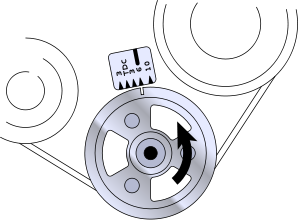
Timing mark
Encyclopedia

Ignition system
An ignition system is a system for igniting a fuel-air mixture. Ignition systems are well known in the field of internal combustion engines such as those used in petrol engines used to power the majority of motor vehicles, but they are also used in many other applications such as in oil-fired and...
of an engine
Engine
An engine or motor is a machine designed to convert energy into useful mechanical motion. Heat engines, including internal combustion engines and external combustion engines burn a fuel to create heat which is then used to create motion...
, typically found on the crankshaft
Crankshaft
The crankshaft, sometimes casually abbreviated to crank, is the part of an engine which translates reciprocating linear piston motion into rotation...
pulley (as pictured) or the flywheel
Flywheel
A flywheel is a rotating mechanical device that is used to store rotational energy. Flywheels have a significant moment of inertia, and thus resist changes in rotational speed. The amount of energy stored in a flywheel is proportional to the square of its rotational speed...
, being the largest radius rotating at crankshaft speed and therefore the place where marks at one degree intervals will be farthest apart.
On older engines it is common to set the ignition timing
Ignition timing
Ignition timing, in a spark ignition internal combustion engine , is the process of setting the angle relative to piston position and crankshaft angular velocity that a spark will occur in the combustion chamber near the end of the compression stroke...
using a timing light
Timing light
thumb|right|300px|Timing light, combination instrument with RPM, volt meter and dwell angle meter. The actual light is on the far end.The black clamp connects to the battery's -, the red clamp to +, the green one to the breaker side of the coil , the big black clamp in the foreground is an...
, which flashes in time with the ignition system (and hence engine rotation), so when shone on the timing marks makes them appear stationary due to the stroboscopic effect. The ignition timing can then be adjusted to fire at the correct point in the engine's rotation, typically a few degrees before top dead centre and advancing with increasing engine speed. The timing can be adjusted by loosening and slightly rotating the distributor
Distributor
A distributor is a device in the ignition system of an internal combustion engine that routes high voltage from the ignition coil to the spark plugs in the correct firing order. The first reliable battery operated ignition was developed by Dayton Engineering Laboratories Co. and introduced in the...
in its seat.
Modern engines usually use a crank sensor directly connected to the engine management system.
The term can also be used to describe the tick marks along the length of an optical mark recognition
Optical mark recognition
Optical Mark Recognition is the process of capturing human-marked data from document forms such as surveys and tests.-OMR background:...
sheet, used to confirm the location of the sheet as it passes through the reader. See, for example, U.S. Patent 3,218,439 (filed 1964, granted 1965), which refers to a timing track down the left side of the form, and U.S. Patent 3,267,258 (filed 1963, granted 1966), which refers to a column of timing marks on the right side of the form.

